2019 Honda Passport: What's It Like to Live With?
Road trips and demanding hauls are no problem, but the Passport is tripped up by tech.
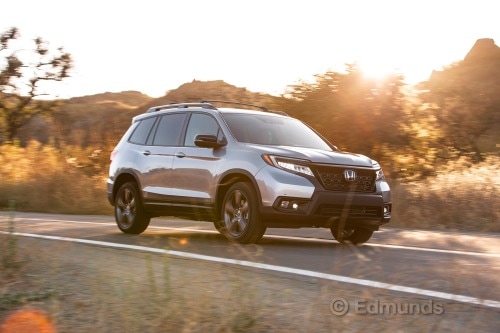
| Miles Driven | Average MPG |
| 20,389 | 20.6 |
Latest Highlights (updated 09/30/20)
- Comfortable crossover takes the stress out of road trips
- Storage dimensions amenable to large, oddly-shaped objects
- Smooth and strong powertrain easy to adjust to driver's liking
- Infotainment and collision mitigation leave much to be desired
What do you want to know about?
What We Bought and Why
• Our test vehicle: 2019 Honda Passport Touring AWD
• Base MSRP: $42,275 (including $1,095 destination)
• MSRP as tested: $42,275
As you'll see below, we had several pressing questions about the Honda Passport that we hoped to answer with a yearlong test. Here are the biggest takeaways from our 20,000 miles with the Passport:
Best characteristic: Versatility
Best feature: Very accommodating cargo space
Biggest surprise: Impressive 10-speaker stereo quality
Biggest disappointment: Infotainment crashes; frustrating automated aids
Longest road trip: 5,185 miles (L.A. to Louisiana, then Chicago and back)
Highest elevation: 8,200 feet (Wrightwood, California)
Nights camping: Eight
Strangest cargo: Goats
Who wants to hit the outdoors? Take one look at the Honda Passport and it's clear the SUV is meant for two things: hauling a bunch of stuff and getting dirty.
There's been a noticeable rush of automakers coming out with vehicles, including the Subaru Ascent and Kia Telluride, that bridge the gap between fuel-efficient crossovers and traditional rugged SUVs. The all-new Honda Passport is one of the latest examples, giving outdoorsy buyers an alternative to the smaller CR-V.
It brings Honda's clever design and trademark reliability into the equation, with a 3.5-liter V6 engine (280 horsepower, 262 lb-ft) mated to a nine-speed automatic transmission. That's a recipe for success, and a big reason why the Honda Passport is our No. 1-ranked midsize SUV.
What Did We Get?
We chose a 2019 Honda Passport Touring AWD. It sits above the Sport and EX-L trims but below the top-end Honda Passport Elite in the model lineup. We think the Touring will be most popular with buyers due to its relative value and a long list of standard convenience features including navigation, roof rails, LED headlights, a hands-free tailgate, and heated front and rear seats. Both Apple CarPlay and Android Auto are standard. Naturally, we also added all-wheel drive (a $1,900 option) to bring our total to $42,275.
Why Did We Get It?
To get muddy. The Honda Passport is built to tackle adventures and that's exactly what we intend to do. In our first week of ownership, the Passport took a 2,000-mile trip to Oregon and back. Shortly after that it trekked to a coastal state park for a weekend of camping. It's used torque-vectoring to haul mountain bikes up twisting roads, used all-wheel drive to explore dirt trails, and conquered some of the nastiest potholes L.A. has to offer. And we're just getting started.
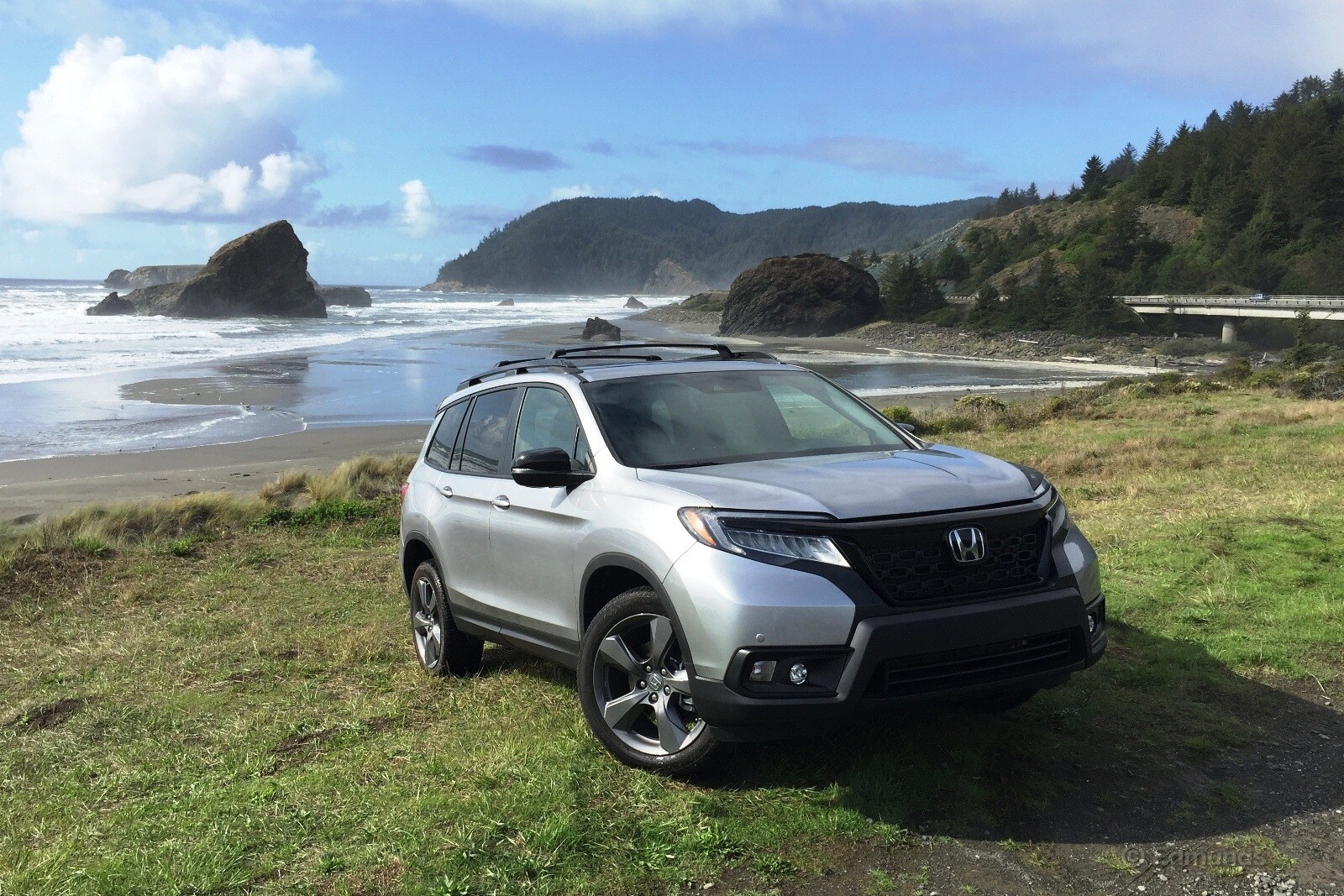
The Honda Passport has already shown a propensity for comfortable long-distance cruising. So let's kick things off with a road trip theme. Here's what vehicle test editor Kurt Niebuhr had to say after his time behind the wheel:
"I have a feeling we're going to put a lot of miles on our Passport. It's really comfortable, there's great visibility all around, and the V6 engine is crazy smooth at all speeds. Just to pile it on, the steering is light but confident and the driving position is spot-on."
The interesting thing here is that, by all accounts, the Honda Passport excels at the ease and convenience of driving. It borrows comfort from the three-row Honda Pilot and versatility from the two-row CR-V, adding a dash of off-road flavor along the way. The Honda Passport can do many of the things weekend warriors will require of it without the harshness and poor ride quality of a traditional 4x4 SUV.
Now, we don't expect the Honda Passport to scratch and claw over a treacherous boulder trail, but it makes us wonder: Just how far can you push it? Where will the all-wheel-drive system go? What can you fit behind the rear seats? We'll continue to investigate over the next year. Follow our thoughts here on how the Honda Passport is performing in several key categories.

What Did We Learn?
When we first got it, we said that we wanted our long-term Passport to hit the outdoors. And even with a surprise pandemic hanging a dark cloud over the final six months of ownership, that's exactly what it did.
Now that our long-term test has come to a close, the Passport is back with Honda. The automaker loaned the vehicle to us since it isn't feasible to purchase each one on our wish list. Our time with the Passport allowed us to gain an accurate understanding of the ownership process, from ride comfort and fuel economy to handling maintenance and recalls.
Anytime we asked a lot of it, the Passport dutifully agreed. We just wish Honda would tighten up the technology — our crashing infotainment seems to have been fixed by a recall, but the collision warnings and adaptive cruise control should be better in a vehicle of this caliber. Still, after 20,000 miles, color us impressed with the versatility of this "soft-roader" to provide a more amenable alternative to the Jeep Grand Cherokee and Toyota 4Runner.
The manufacturer provided this vehicle for the purpose of evaluation.
2019 Honda Passport: Real-World Fuel Economy
The Passport has shown impressive fuel economy, likely due to several long-distance trips with lots of highway miles early into its short life. The lifetime mpg is a hair below its combined rating from the EPA. Overall, the Passport is especially strong compared with adventure-based vehicles like the Toyota 4Runner and Jeep Grand Cherokee. Sure, they're more rugged. But could either touch these numbers? We doubt it.
Average lifetime mpg: 20.6
EPA mpg rating: 21 combined (19 City/24 Highway)
Best fill mpg: 28.5
Best range: 460.1 miles
Current odometer: 20,389 miles
Logbook Highlights
"We gave the Passport a chance to stretch its legs on a massive road trip through most of May. And stretch it did. Most days, the Passport returned impressive fuel economy, including our highest measured mpg (28.5) on a single fill since we took ownership. Over the entire 4,800-mile trip, the Passport posted 22.1 mpg, which made the journey easy and worry-free. It would have been nice to see it beat its EPA-estimated 24 mpg on the highway more consistently, especially with our liberal use of the gas-saving ECO button, but for a roomy SUV we came away pleased by the experience." — Amy Silliman, production manager
"The Passport has a little green Econ button sitting astride the steering wheel that, when pressed, prioritizes fuel economy over performance. I thought I'd try keeping it on for a typical week of driving and see if it made any difference. The short answer is yes. At the end of the week, the Passport averaged 21.6 mpg. That's better than our 20.0 lifetime mpg, but it's well off our highest fill-ups. If you're really prioritizing efficiency, the slow acceleration from Econ mode is one way to go. But I imagine you could do the same (or close to it) simply by keeping a light foot while still getting the lively gas pedal in normal mode." — Ryan ZumMallen, reviews editor
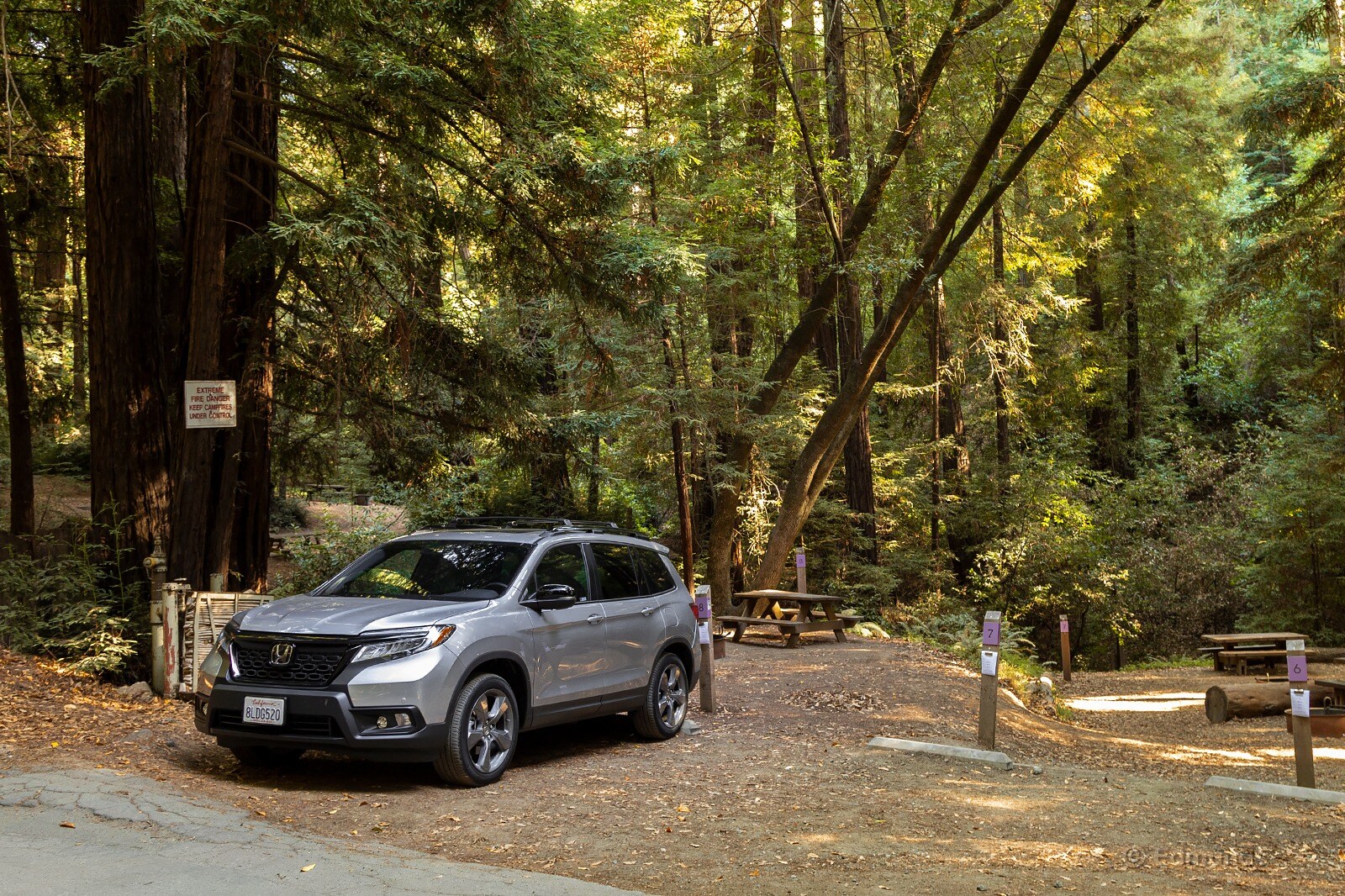
Maintenance Summary
| Total routine maintenance costs | $ 72.26 |
| Additional maintenance costs | |
| Warranty repairs | |
| Non-warranty repairs | |
| Days out of service | |
| Breakdowns stranding driver |
"The recall issued by Honda for Passports, Pilots and Odysseys in July actually raised more questions than it answered for us. So we reached out to Honda for clarification. Here's the skinny: When we alerted Honda to our problems with the display screen shutdowns back in January, they took the Passport back and sent it to an internal quality control center for inspection. There, they tried to troubleshoot the problem and issued an early version of the fix that would eventually lead to that July recall a few months later.
TLDR; our Passport served as a test bed for engineers as they readied a recall for glitchy display screens that tended to get overloaded and shut down (often in the middle of driving). The fix has held up on our end, with no further problems, and there's no reason to think it won't also help Honda owners who've experienced the frustrating glitch in their own vehicles.
Lastly, even though our Passport got the early fix, there may have been changes made after that. So our vehicle will need to get the service at a dealer soon to ensure it has the most current version. Sadly, we're giving the Passport back before dealers will be equipped for the fix. Best of luck, new owners!" — Ryan ZumMallen, reviews editor
"After some alarming malfunctions, the infotainment system hasn't given us any issues over the past six months. It seems the service Honda performed back in February worked as intended. Meanwhile, the automaker in July issued a recall for the Passport, as well as the current-gen Odyssey and Pilot, for a software update to help the display screens from being overloaded and powering down. This also disables the rearview camera, which is a major safety issue. It's unclear if this is the fix Honda gave us months ago, so we'll attempt to bring the Passport in and get it checked out. Check back for updates to see how it went." — Ryan ZumMallen, reviews editor
"We've come to a crossroads with the Passport over its infotainment. A system that at first seemed quirky but acceptable has caused major issues of late, and we've learned we're not the only ones with this experience. On separate occasions, with different drivers behind the wheel, the Passport's screen has suddenly stopped functioning in the middle of driving. The audio shuts off, and the touchscreen refuses to respond to commands. This means you lose whatever navigation, multimedia and other information you may have been using, and can't regain control.
Both times it happened, our editors parked the Passport and turned it off for a short break. On one of those occasions, the screen flashed on and would not turn off even as the vehicle stopped running and the doors were locked. We contacted Honda, who brought the car in and issued a service to fix the "running infotainment" problem. The automaker says the fix will be available to owners as an over-the-air update soon (click here to access Honda's owner update site, under 'Software System Updates,' or here for instructions about over-the-air updates). But it does not solve the initial problem, which is a total shutdown of the infotainment system while the Passport is moving.
This is a frustrating situation for buyers. It does not reflect well on the quality of the Passport's software, and causes a potential distraction hazard at speed. At time of writing, the problem has not occurred in more than two months, and there have been no issues in the short time since Honda completed its service. But we've learned other owners have had similar experiences in Passport, Pilot and Odyssey models. The company is "working to provide market repairs which include software and hardware fixes," we were told. Unfortunately, that's a hard answer to swallow. We will report back if any further issues arise." — Ryan ZumMallen, reviews editor
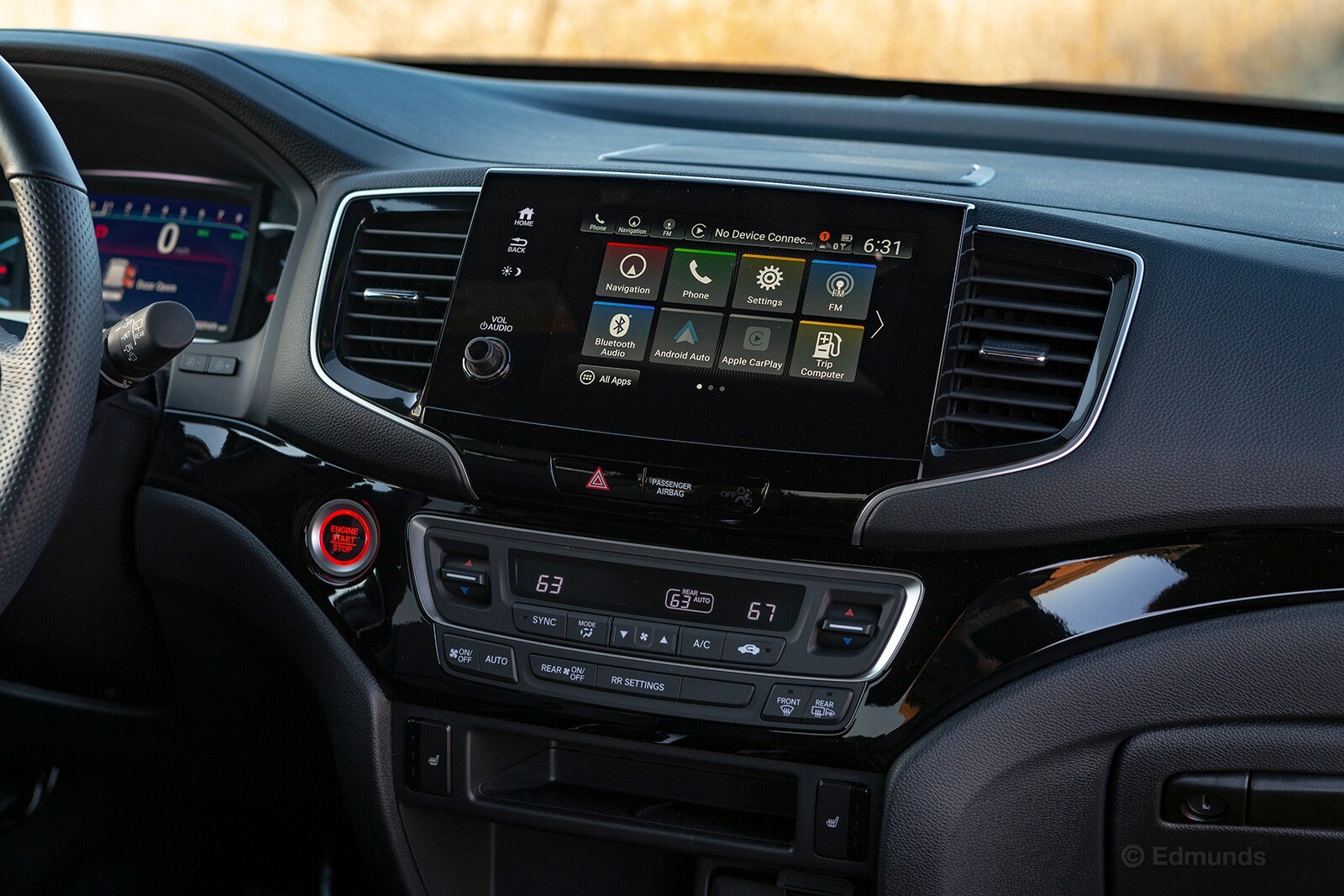
"My family's annual holiday trip to see relatives in Oregon begins the day after Christmas, and the Honda Passport is this year's chosen sleigh. But the 'needs maintenance soon' light was there to greet me the first time I slipped behind the wheel to take it home. Of course.
I guess I was surprised to see this so soon. But the odometer doesn't lie, and some 7,200 miles is testament to just how popular the Passport is among the staff.
The warning system indicated this would be the first 'A1' maintenance visit, which in Honda-speak is a simple oil change and tire rotation. It wouldn't be smart to put either of these off just before a 2,000-mile trip, so I headed over to Hardin Honda for some early morning Express Service. It took just over an hour, at a cost of $72.26 for the labor, the filter and five quarts of 0W20 synthetic motor oil.
Good to go." — Dan Edmunds

"It actually rode smoother than I expected. Likewise, feedback from passengers agreed it was not that rough of a ride in the back seats. However, I have experienced better continued acceleration and handling in other SUVs in this class." — Jodi Tourkow, senior director, written content
"I'm enjoying our Passport's performance. The V6 engine boots this SUV up to speed with authority and sounds pretty cool when doing it. It also pairs pretty well to the nine-speed automatic transmission. The transmission can seem just a tad slow to downshift sometimes but in general it shifts smoothly and picks optimal gearing. I also like that you can take a bit of extra control by selecting the Sport mode (it quickens up the gas pedal's responsiveness and has the transmission rev up the engine more) or using the manual transmission shift paddles." — Brent Romans, senior editor, written content

"There were many mountain passes along our holiday route through Northern California and Southern Oregon, and in most cases the Passport proved to be admirably capable and comfortable. The chassis is nicely calibrated to deliver steady handling even when the roads are lumpy and uneven. Its remarkably steady ride permanently resides in that sweet spot between too hard and too squishy. The steering feels direct and communicative, too, whether cruising straight or arcing through long sweeping bends.
The V6 engine has ample power, and the nine-speed transmission finally has a calibration that works in most situations.
Most is the operative word here. The many downgrades we faced along the way revealed a consistently annoying trait. Pull the "minus" shift lever to rein in speed on a downgrade (something I did often with this leverless pushbutton nine-speed) and you'll get an annoying lurch FORWARD as the transmission seemingly goes into neutral before reluctantly giving you the lower gear. Such downshifts in other cars almost never have the odd feeling that the vehicle goes into neutral and picks up speed before downshifting, but that was consistently the case here. When the shift does happen, rpms jump more than they should as the system attempts to catch up with events. Clearly, a flatlander tuned this thing. The downshift from one gear to the next needs to be blended. This is not good, especially if you are driving in the mountains." — Dan Edmunds, director, vehicle evaluation
"Overall, the Passport is a good road trip car, from its commanding view down the road to comfortable seats and true steering, it's an easy companion. The one issue was the suspension, which is mostly solid but has some weaknesses. The right lane of California's 5 freeway has been potholed by the constant stream of heavy freight trucks, and the Passport had trouble with those at freeway speeds. The sharp hits were translated into the cabin, and came with significant pinging noise." — Will Kaufman, content strategist
"I personally dislike foot pedal parking brakes, but it's not a tech or functionality issue (I actually don't mind the functionality). It's that I like to wear sandals sometimes when it's hot, and that extra pedal might as well be called the toenail destroyer. Ouch." — Will Kaufman
"We're on record as fans of the Passport's comfortable front seats, but the back row feels paper thin and lacks any lateral support. Long trip passengers, beware." — Amy Silliman, production manager
"We used the Passport on a recent shoot for getting people around and moving production supplies. The gold standard for video shoots is a cargo van, but it's nice to have an SUV once in a while to treat your crew. The Passport is a nicer ride and feels better, even though it's smaller.
All five seats were taken up and people had gear in their laps. Even the 6'2" guys had enough room. It was quite impressive that they weren't hunched over like in other cars. I was surprised by that. We filled up that backseat all the way to the top. And it didn't drive any differently." — Amy Silliman

"I've driven our Passport Touring a few times now between Los Angeles and Fresno, California. The drive time is about 4 to 5 hours each way. Pleasingly, I've found the Passport's driver's seat to be comfortable.
Now, I'm 5-foot 10-inches tall and kind of skinny, so your results might vary. For instance, I have heard that some shorter drivers might find the seat positioned a little too high for their tastes. But overall my guess is most people will like the driver's seat.
The seat cushion and backrest are supportive without being too confining, for instance. I've also been able to use the power adjustments to set the seat set the way I like. Another nice touch is the inboard armrest. You can ratchet it to the angle you like, and it's set at the same height as the armrest on the door, so you can comfortably rest both arms on while making a long highway cruise. " — Brent Romans, Senior Editor, Written Content
"Not impressed with the A/C in this Honda. Even right at the vent, the air coming out is cool on the hand, not cold. By the time it gets to a strapped-in passenger's body, it's not doing a whole lot of work. More than once I've checked to see if I'd inadvertently turned the A/C off. Nope, always on. Just not particularly effective." — Josh Sadlier, director, content strategy

"Pay attention to the position of the Passport's roof rack cross bars. If you spread them too far apart and place the front one well forward it will create wind noise you can hear up through the sunroof.
Sliding both all the way back as far as they'll go is no picnic, either. Here they join forces to create a swirling cacophony that sound like an arctic storm. It's bad enough that front seat passengers can hear it, but it really howls in the back seat.
The trick is to split the difference in a very specific way. The rear one goes nearly all the way back, but the front one needs to be in the approximate zone where the front and rear doors meet. You can tell precisely where by stepping up onto the rear door sill and looking down. There you'll find two small countersunk dots that are meant to be aligned with arrows molded into the crossbars. Loosen the knobs to adjust them as you would, but let these dots be your guide.
So positioned, wind noise is truly minimal when the rack is empty, yet the span is still broad enough to stabilize the typical load. And don't assume the dealer set them up correctly before you bought the vehicle. Our front bars were almost ten inches too far forward at first, and the resulting wind noise was much more noticeable than it is now." — Dan Edmunds, director, vehicle evaluation
"I was pleasantly surprised by the sound quality of the Passport's stereo. I feel like Honda's premium stereos tend to feel a little...flat and soulless. But the few moments I could steal in the Passport without the baby were improved by the stereo. I didn't realize how much I missed loud music. Rock and roll!" — Will Kaufman, content strategist
"I think the adaptive cruise is my single biggest complaint about the Passport. It's the worst among segment leaders: It's overly sensitive and not very smart, stopping too sharply when a car changes lanes in front. Oddly, that problem only seems exacerbated by increasing the follow distance. And that's not even bringing up the fact that it doesn't work at low speed." — Will Kaufman
"A sneaky great feature in the Passport is the Multi-Angle Rearview Camera, which includes a super wide shot that allows you to see what's coming way down the street or sidewalk while you're backing out. These are becoming more common industry-wide, but they're usually optional and can be part of quite expensive packages. Honda, meanwhile, made it standard on every Passport." — Ryan ZumMallen, reviews editor
"I'm enjoying the sound system in our Passport. Honda fits the Touring trim (like our test car) and the top-level Elite with a a premium sound system. It's a 10-speaker system (including a subwoofer) with 540 watts, compared to the base system's 7-speaker and 215 watts. (Broadly, more speakers and a higher power capability provide the potential for better sound quality.)
I mostly listen to hard rock and alternative music, and I've found the Passport's system is up for the task. It produces strong bass and can crank up loud without distorting if that's what you like. Honda also provides impressive amount of adjustments through the touchscreen interface. You can adjust the sound levels for the subwoofer and center front speaker individually, for instance, or quickly adjust the system to prioritize specific zones: full vehicle, driver only, front seating or rear seating.
This system lacks the detailed audio nuance that you'd get from a quality sound system in a luxury-branded vehicle, but overall it's a solid system and helps justify the stretch to get a Touring or Elite." — Brent Romans, Senior Editor, Written Content
"Not impressed by the Passport's adaptive cruise control system. What does a good ACC do? Number one, it picks up the car in front of you with time to spare, and brakes smoothly and gradually if braking is necessary. Number two, once that slower car is out of the way, it gets you back up to speed with reasonable haste. The Passport is iffy on both fronts, in my experience. Too often, it picks up vehicles late and then overreacts, slowing me way down when I just needed a dab on the brakes. Then, when the coast is clear and I'm down to, say, 60 mph from my 74-mph set speed, the acceleration back up to 74 can be positively glacial. I'm holding everyone up behind me as the digital speedometer ticks through 61, 62...63...gah! I've taken to handling the acceleration myself, because otherwise I feel bad being that guy. The system works well enough that I kept using it throughout my trip, but these limitations are unfortunate." — Josh Sadlier, director, content strategy

"Welp, the Honda FCW false alarm trend continues unabated. I had no fewer than six false alarms that included a huge flashing "Brake" warning on the dash, accompanied by a wheel shake. This is the impending doom warning that requires immediate action. Trouble was, none involved any peril whatsoever. All were false triggers based on oncoming traffic on two-lane sections of the highway. Three happened within five minutes, with two of those 15 seconds apart. Really, Honda? We've seen the same thing on long term examples of the CRV, Civic, Pilot and Ridgeline. No other brand has nearly as many false alarms. Your system sucks if I feel safer turning it off." — Dan Edmunds, director, vehicle evaluation
"Circumstances required us to leave home for a week with our five-month-old baby, and we couldn't have done it without the Passport. We brought everything all three of us needed, including a stroller, cot, high chair, and food. And it all fit in the trunk without fully obstructing the rear view. The Passport gets top marks for practicality." — Will Kaufman, content strategist
"Almost nothing this side of fullsize trucks offers as much cabin storage as the Honda. The Passport handled food, drinks, hand sanitizer, wipes, masks, sunglasses, and phones with ease, keeping everything organized." — Will Kaufman
"Not all cargo is created equally. The Passport has a pretty accessible rear hatch space, but the high load floor makes it a challenge for dogs to hop inside — on road trips that means you'll be doing some heavy lifting over and over again." — Amy Silliman, production manager
"This weekend the Passport escorted us to a local camping spot for the night. It was the perfect size to carry two adults, two kids and our associated baggage. Our tendency to over-pack combined with extra food (we were hosting five other families) meant the cargo area was floor-to-ceiling in some places. But that kept the passenger compartment gear-free, which is always my preference." — Mike Schmidt, senior manager, vehicle testing operations

"I was surprised that my dog's crate fit in the back because the load floor is quite high. I don't need that underfloor storage, so it would be nice if they used that to make the cargo area bigger. That was a little disappointing. While on set for a video shoot, I wasn't sure it was going to work for carting as much stuff as I wanted. But it actually did. We were carting around a good amount of people and always had a full backseat." — Amy Silliman

"The Passport was well equipped to accommodate 4 adults plus loads of fitness equipment, chairs, a canopy and a cooler bag on wheels as we headed to a Crossfit competition. Everything fit nicely horizontally in the cargo space without us having to lay down the rear seats. Unloading was efficient, too. We pressed a button in the cargo space area that automatically laid down the rear seats, making it easier to unload from the back and from the rear doors. Though it doesn't have a sensor in the back to automatically open the trunk space, the ability to press a button to close the trunk (especially when hands are full) is nice." — Jodi Tourkow, senior director, written content

"The Passport is probably the perfect vehicle for two people to use to go camping. Most everything big, heavy and bulky fits behind the rear seats and below the window line. And soft stuff can be placed on the rear seat. There's even underfloor trunk storage for propane (and propane accessories) and other stuff you don't want to have rolling around. The load height is near perfect and the rear doors open nice and wide." — Kurt Niebuhr, road test editor

"On a trip to scout video locations in the desert, we wanted to sample a Passport competitor and see how it handled the mission. We chose the Subaru Ascent. While it's got three rows to the Passport's two, the Ascent is more adventure-minded than most crossovers. It has standard all-wheel drive, good ground clearance and lots of available technology. So it seemed a good match.
The first difference you notice is the way the Ascent drives. Surprisingly, it has a half-inch of ground clearance over the Passport, but you feel closer to the road than you do in the Honda. The Ascent drives like a large Outback, in fact a surprisingly nimble one. Due to its one-inch lift, the Passport feels more lofty and while it's also maneuverable, the heightened center of gravity is apparent.
A turbocharged four-cylinder engine may sound small for a three-row crossover, but on the contrary, the Ascent has plenty of power at all speeds. The throttle may even be a little too jumpy at the start. But once on the road it's a smooth powertrain with a comfortable ride. Just be aware that the Ascent lets in more road noise and has an unpleasant engine whine compared with the Passport.
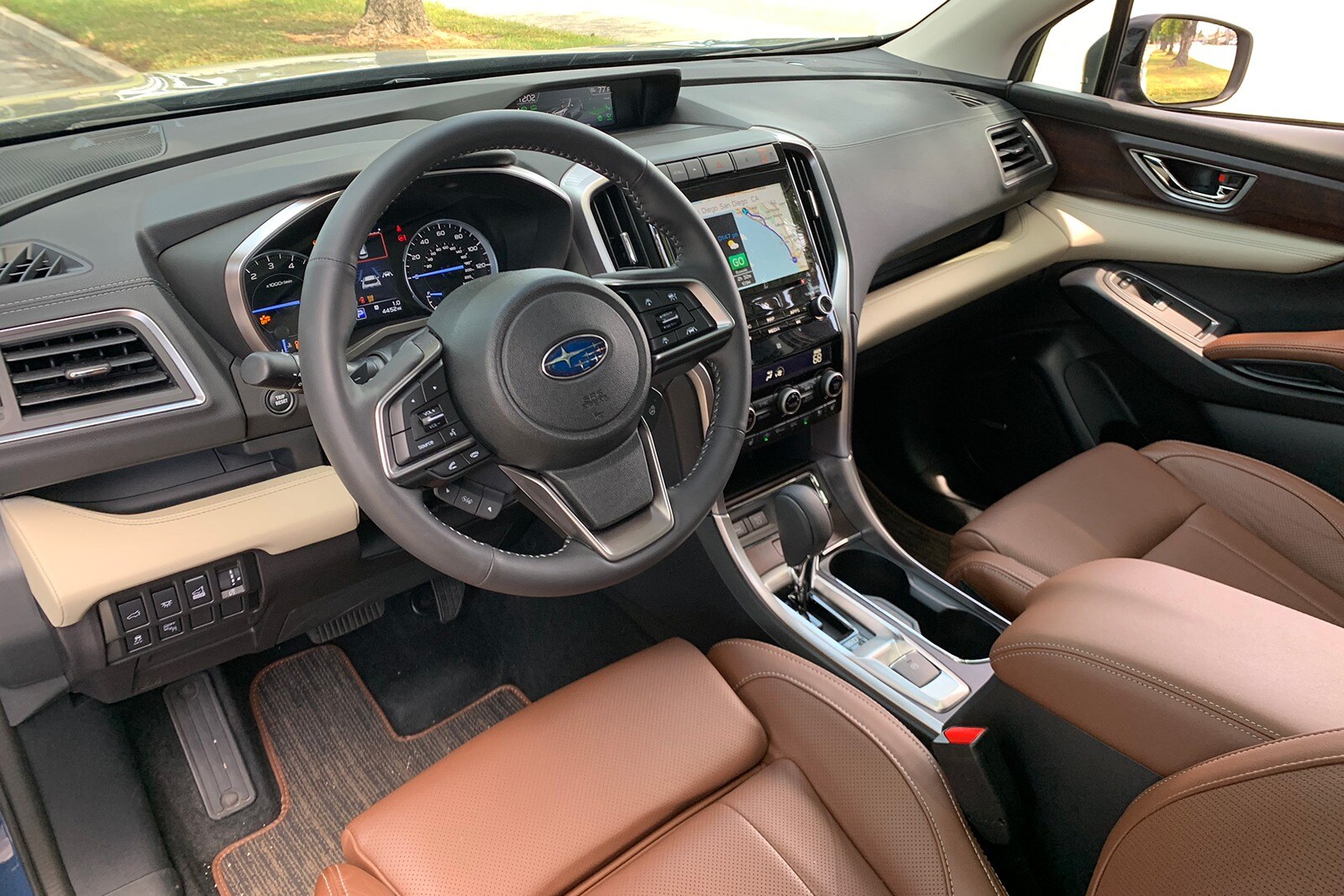
Right away, the Subaru's infotainment seems superior. We've had issues with the Passport system, and then it went through a crashing issue on top of that before Honda issued a fix. By contrast, the Ascent 8-inch Starlink system worked great, integrated with Bluetooth and Apple CarPlay and, most importantly, was easy to navigate through the menus. One downside is the rearview camera, which works fine, but is not great resolution and doesn't come with the wide view we've come to appreciate in the Passport.
Another contrast was the safety driver aids. The Passport's adaptive cruise control is not our favorite, with abrupt braking and awkward transitions when asked to speed up on the highway. The Ascent ACC, on the other hand, felt composed in all situations. Oddly you can only adjust the speed in 5-mph increments. But it works well and meshes seamlessly with lane keep assist to round out a pretty impressive semi-automated driving system.

There are lots of unique quirks to like in the Ascent. Our top Touring model came with two USB ports for the second row and two more in the third row, plus an info screen on the dash and manual rear sun shades. One of the things we like about the Passport is a helpful step next to the second row seats to stand on while reaching equipment on the roof rails. But the Ascent has this step, too, and its lower height makes the rails easier to access anyway.
Overall, the Ascent is an impressive crossover. If you need all three rows, it's an adventurous alternative to the Pilot. If you don't, it's more maneuverable and efficient than the Passport, with better infotainment and safety tech. The Ascent is more expensive. Our test vehicle without options rang in at $46,055 with destination. That's more than our Passport Touring at $42,225, and still more than $1,000 over a top-trim Passport Elite. This is big money for what should be accessible family-friendly crossovers. A savings of four large is making our Passport seem the better deal here. But the Ascent is certainly worth a look, and a week behind the wheel provided valuable perspective for our long-term evaluation.
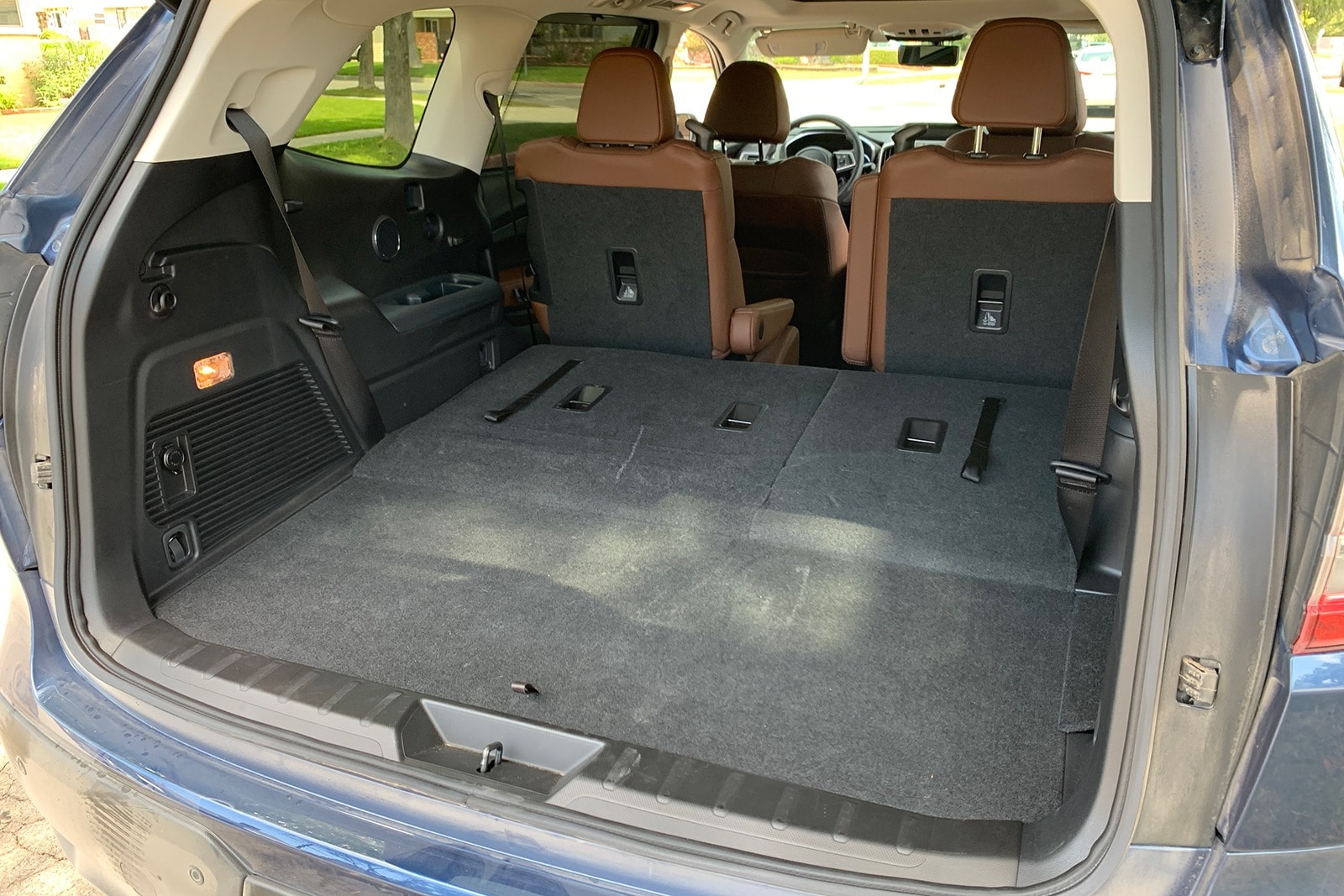

"The Passport was a pleasant companion on my long highway haul to Oregon, despite my kvetching elsewhere on this page. It tracks straight and true at 70-75 mph with few steering corrections required, while the cabin stays quiet on most surfaces. I'd like more rearward driver-seat travel — a recurring Honda bugaboo — but even so, I never emerged at a rest stop feeling sore or fatigued. I wouldn't hesitate to take this rig out on the open road again; in fact, I might request it." — Josh Sadlier, director, content strategy
How reliable is a Honda Passport after 20,000 miles of use? Find out as Edmunds wraps up its ownership of a 2019 Honda Passport. This video covers what we liked and what we didn't as well as fuel economy, reliability and other attributes.